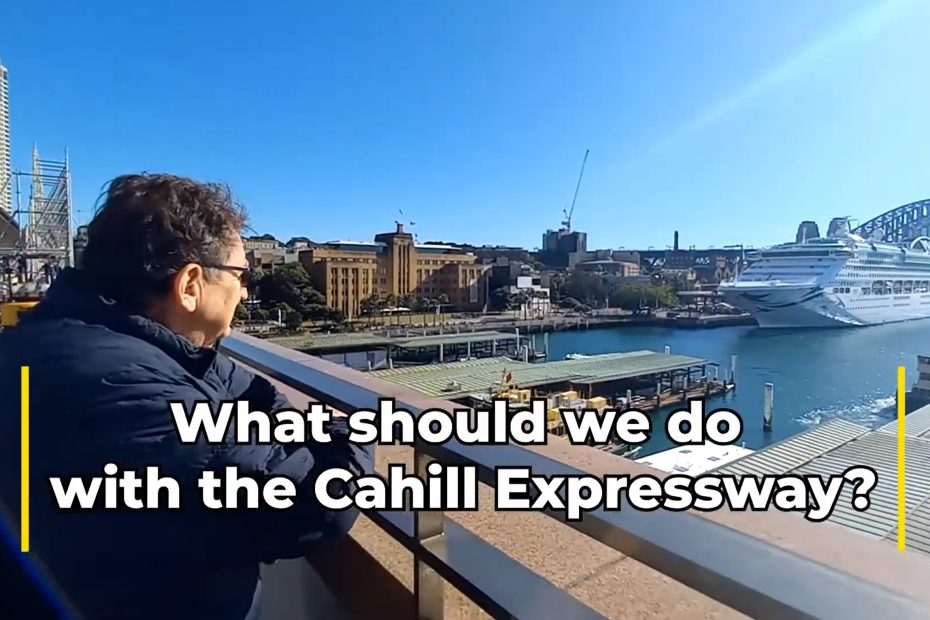“The Cahill Expressway divides the city from the harbour — and it does. It probably should never have been built that way. But it’s here, and we can make it work for the public good.”
— Colin Schroeder, EcoTransit Sydney
For over sixty years, the Cahill Expressway has loomed over Circular Quay — one of Sydney’s most recognisable and contested pieces of infrastructure. Built in the early 1960s above Circular Quay Station, it symbolised the mid-century dream of a car-dominated city. Trams were removed from the Harbour Bridge’s eastern lanes to make way for motor traffic, and an elevated highway was seen as a bold statement of modern progress.
Today, the Cahill Expressway is more often viewed as a concrete barrier that divides Sydney from its harbour. For many, its demolition seems inevitable. But for EcoTransit Sydney, the better question is: how can we make it useful again?
In a previous EcoTransit Sydney video discussion, long-standing member Colin Schroeder outlined an alternative vision — one that transforms the expressway from an outdated roadway into a public transport interchange and civic connector.
Repurposing the Cahill
EcoTransit’s proposal calls for adaptive reuse rather than demolition. The concept is simple: redesign the upper deck of the expressway to carry dedicated bus lanes in both directions, alongside limited car access for essential traffic. From there, passengers could transfer via lifts, escalators, and stairs directly to Circular Quay Station, the light rail, and ferry wharves below.
This reconfiguration would allow buses from Sydney’s north to terminate at Circular Quay instead of entering the CBD, removing congestion from city streets and freeing space for pedestrians, cyclists, and green public areas. A turnaround loop near the Conservatorium of Music could enable buses to return north or continue east through the Eastern Distributor — creating a seamless, low-impact interchange.
As Schroeder explained:
“It’s about re-using an existing public asset rather than spending billions of dollars tearing it down. That money could fund more rail and light rail projects elsewhere in Sydney.”
Linking with “Two More Tracks” on the Harbour Bridge
The Cahill proposal complements another long-running EcoTransit campaign: “Two More Tracks on the Harbour Bridge.” In the companion EcoTransit video, members explain how restoring the two rail tracks once used by trams on the Harbour Bridge’s eastern lanes could increase cross-harbour capacity by up to 40%.
Together, these ideas form a coherent, achievable vision — leveraging Sydney’s existing infrastructure to deliver large-scale benefits in connectivity, emissions reduction, and urban liveability. Rather than relying on disruptive mega-projects, EcoTransit’s approach prioritises smarter use of what the city already has.
Timing Matters: Circular Quay Renewal
The NSW Government’s Circular Quay Renewal is already reshaping the city’s most iconic gateway. The project involves rebuilding ferry wharves, expanding the public domain by over 14,000 m², and upgrading Circular Quay Station with new lifts and concourses. A consortium led by Capella Capital, Lendlease Construction, and BESIX Watpac is steering the design and construction.
Meanwhile, the City of Sydney is advancing its own pedestrian and public space improvements — such as the Loftus Street upgrade, which will add new trees, outdoor dining, and wider footpaths.
In this context, EcoTransit’s ideas couldn’t be more relevant. Repurposing the Cahill Expressway as a multi-modal interchange would knit together rail, bus, tram, and ferry connections at precisely the moment when the precinct is being renewed for the next century.
Why EcoTransit’s Approach Works
Cost-effective: Demolishing or tunnelling under the expressway could cost between $5 and $10 billion and take years to complete. Repurposing the existing structure achieves many of the same outcomes for a fraction of the cost.
Practical: A Cahill interchange could become the only point in Sydney where all major transport modes — train, light rail, bus, and ferry — converge vertically within one location.
Climate-friendly: Diverting car trips to electrified public transport helps reduce emissions and supports Sydney’s climate and sustainability goals.
Place-making potential: The upper deck could feature landscaping, seating, and harbour viewpoints — transforming the expressway from an urban scar into a public space with purpose.
Network logic: Combined with EcoTransit’s call for two additional bridge tracks, the Cahill interchange could anchor a more resilient and interconnected transport network extending across the metropolitan area.
From Barrier to Catalyst
The Cahill Expressway has long symbolised the dominance of cars in Sydney’s urban planning. But it doesn’t have to stay that way. With imagination and political will, the structure could evolve into something entirely different — a civic platform that reconnects Sydney with its harbour and serves as a model for how infrastructure from the past can be reused for the public good.
“This is about how Sydney chooses to see itself,” Schroeder said. “The Cahill Expressway can remain a monument to car dependency, or it can become a symbol of renewal, connection, and sustainability.”
As Sydney invests billions into transforming Circular Quay, EcoTransit Sydney urges decision-makers, planners, and the public to think boldly about how to use the city’s transport heritage.
Get Involved
Watch EcoTransit’s full interview with Colin Schroeder and the companion “Two More Tracks” video to explore these ideas in more detail.
Stay connected by joining the EcoTransit Sydney mailing list, following our campaigns, and taking part in the conversation about how Sydney can build a cleaner, more connected, and more equitable transport future.
EcoTransit Sydney acknowledges the Traditional Custodians of the land on which Circular Quay (Warrane) stands and pays respect to Elders past, present, and emerging. We recognise that transport decisions made today will shape how future generations experience this place — and that true sustainability must respect both Country and community.
